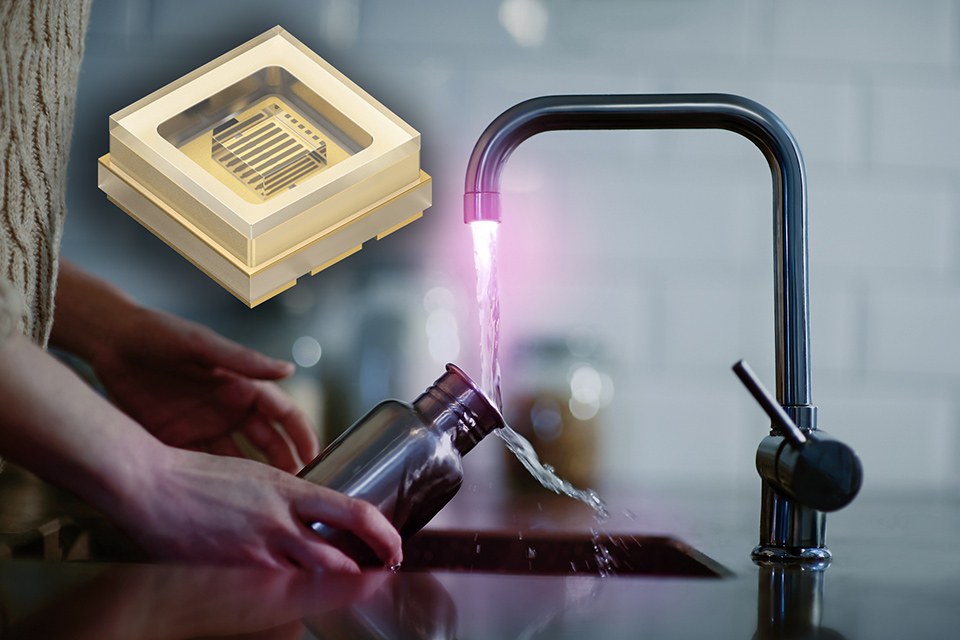Osram Enters UV-C LEDs Market Offering Their First Products
The longer the coronavirus pandemic lasts, the more important it is to stay safe and healthy in everyday life. Hygiene measures, such as wearing a facemask or socially distancing, help safeguard against the spread of germs. But light in the right wavelength also makes an enormous contribution to fighting viruses. UV-C light can eliminate 99.9 percent of viruses and bacteria on surfaces, in the air and in drinking water. As one of the world's leading manufacturers, Osram Opto Semiconductors now enables particularly small and robust disinfection applications with its LEDs, while also driving the industrialization of these special light sources forward. The Oslon UV 3636 marks the beginning of a comprehensive portfolio in the UV-C LED sector.
Irradiation with UV-C light causes chemical bonds in the RNA or DNA helix of the pathogens to break down. As a result, they are no longer able to multiply and are thus rendered harmless. UV-C light has been used for many years to disinfect air or water - but often with very large lamps based on conventional light technologies. A major advantage of modern, LED-based UV-C solutions is the compact size of the light sources. Thanks to their space-saving dimensions, the LEDs can be installed easily on the final application for direct interaction with the substance being sanitized such as: significantly reducing germs in faucets and disinfecting the air in air conditioning systems before it is blown into car interiors. The direct integration of the light sources also has the advantage of ensuring that the high-energy, short-wave UV-C light does not reach the surrounding area, and therefore, does not pose a risk to people. In addition, unlike conventional lighting technologies, LEDs are very robust and insensitive to external shocks.
Oslon UV 3636, Osram's first UV-C LED, is available in a low- and a mid-power version and features compact dimensions of 3.6 mm x 3.6 mm. With a wavelength of 275 nanometers, both versions are ideal for disinfection applications. The low-power version achieves 4.5 milliwatts at 30 milliamperes. The mid-power version impresses with 42 milliwatts at 350 milliamperes.
"Thanks to their compact footprint and different optical power classes, UV-C LEDs enable completely new designs and applications," explains Christian Leirer, Product Manager for UV-C at Osram Opto Semiconductors. "The Oslon UV 3636 is the first product in a series of innovations from Osram Opto Semiconductors in the UV-C range. A high-power UV-C LED will be launched in early 2021."
Osram has been active in the UV area for many years and developed in-depth knowledge of UV technology from participating in various research projects with partners from industry and research. Particularly noteworthy are the UNIQUE and UV-Power project, as well as IPCEI on Microelectronics.
Further information about disinfection can be found at https://www.osram.com/os/applications/uv-c/index.jsp
You are also welcome to contact our technical support colleagues at https://www.osram.com/os/contact/forms/technical_support.jsp
About Osram:
Osram, based in Munich, is a leading global high-tech company with a history dating back more than 110 years. Primarily focused on semiconductor-based technologies, our products are used in highly diverse applications ranging from virtual reality to autonomous driving and from smartphones to smart and connected lighting solutions in buildings and cities. Osram uses the endless possibilities of light to improve the quality of life for individuals and communities. Osram's innovations enable people all over the world not only to see better, but also to communicate, travel, work and live better. Osram had approximately 21,000 employees worldwide as of end of fiscal 2020 (September 30) and generated revenue of around three billion euros from continuing activities. The company is listed on the stock exchanges in Frankfurt and Munich (ISIN: DE000LED4000; WKN: LED 400; trading symbol: OSR). - www.osram.com

